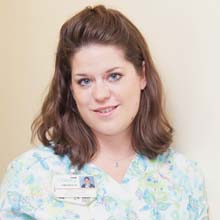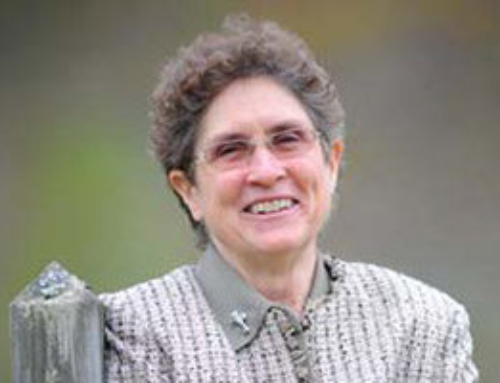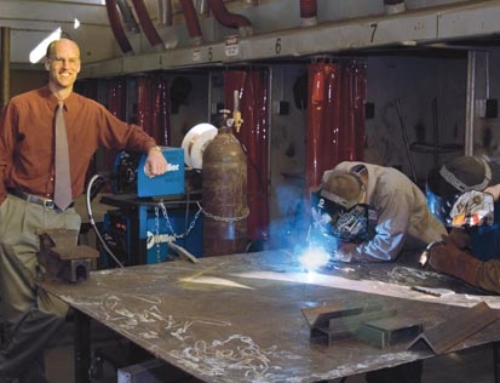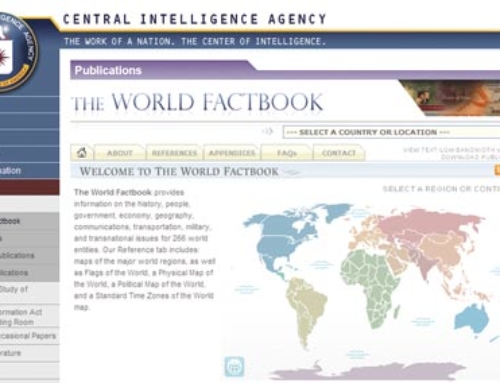 As nurses take on leadership roles, they could change the health care landscape: A look at the future of nursing and its impact on patients.
As nurses take on leadership roles, they could change the health care landscape: A look at the future of nursing and its impact on patients.
In 2010, a landmark report by the Institute of Medicine set forth how nursing practice and education should change in profound ways. Dr. Lois Hamel, director of the online nursing program at Saint Joseph’s, calls the report a prescription.
Simply put, the “The Future of Nursing” report frames nurses as leaders, calling for breakthroughs that place nurses in fundamental roles to transform the nation’s health care system.
“I see the report as inviting nursing to the health care table as a full-fledged and valued team member,” says nursing professor emeritus Sue Henderson.
Nurses have not traditionally been power players when it comes to setting health policy, a territory largely populated by physicians, insurance companies, health care agencies and drug and equipment suppliers. “We’ve worked hard to earn our way in, so the Institute of Medicine citing empirical evidence to state the value of nursing is just huge,” Henderson says.
The Institute of Medicine analyzes challenging issues in the health care industry – looking at the relationship of access, quality and cost – and recommends ways to handle systemic problems. Its mission is to improve health care by providing authoritative, unbiased advice to decision-makers and the public, and its findings are respected by the industry and regulatory agencies alike. Although it doesn’t have authority per se, the Institute of Medicine (IOM) has had profound influence on health care practice and education. Lawmakers and federal regulators pay close attention to the non-governmental organization, which is part of the National Academy of Sciences.
The IOM recommendations on nursing’s future come against a backdrop of immense change at an ever-quickening pace. With the explosion of technology, medical knowledge and acute care, hospital nursing has become much more medically complex and demanding. Yet the focus of health care overall is shifting from acute care in hospitals toward primary care in community-based settings, and as that shift occurs, prevention of disease rather than crisis response to it will play an ever-larger role going forward.
In this context, nursing roles must evolve as well. “It’s a perfect time to implement the IOM changes,” says faculty member Dr. Margaret Hourigan, longtime chairwoman of the college’s nursing department.
At the top of the IOM report’s list of recommendations is one that says nurses should be allowed to practice “to the full extent of their education and training.” It sounds obvious, but it means that advanced practice nurses would be able to practice independently and bill health insurers – as well as have the same titles and responsibilities across state lines, just as doctors enjoy “national licenses.” As it stands now, varying regulations by state for advanced practice nurses (nurse practitioners, clinical nurse midwives, nurse anesthetists, and clinical nurse specialists) can limit their ability to practice and their mobility. Since nurse practitioners often work in medically underserved areas, and since only 2 percent of medical school graduates choose family practice medicine, nurse practitioners being allowed to practice at their highest level of education becomes more and more important.
As it is, some states don’t allow nurse practitioners to diagnose or prescribe, even though they are clinically prepared to handle 80 to 90 percent of usual cases and the rest they refer to physicians. Where nurse practitioners practice fully, physicians can be freed up to see the 10 to 20 percent cases that are more critical. A uniform national standard that allows nurses to “live up to their license,” would mean more patients could be served and at a greater efficiency.
“One reason the IOM report is so powerful is because it’s evidence-based,” says Hourigan. “Research shows patient outcomes are no different when patients see a nurse practitioner compared to when they see a family practice doctor,” she notes.
Another IOM recommendation calls for nurses to achieve higher levels of education to respond to increasingly complex patient care. The report states further that nursing education should elevate leadership components that help nurses shape health policy, system improvement, research and evidence-based practice, teamwork and collaboration – along with much-strengthened content areas in community, public and geriatric health.
Hourigan believes the IOM’s recommendations will boost health outcomes for patients and help create a system that truly addresses the sacred triumvirate: health care that is high-quality, affordable and accessible. For example, higher education levels mean that nurses are better prepared to do broad assessment of a patient along with a patient’s support system and community, all of which leads to identifying potential problems earlier. That translates to quicker, easier and cheaper treatment. “It means the ER will be used for true emergencies, such as chest pain and trauma,” says Hamel.
New roles and ways of delivering care
Lori Rumery ’03 has been a nurse for 20 years. She remembers when nurses carried the patient charts as they walked along behind the doctor or gave up their chair as soon as the doctor approached the nurses’ station. Now she works as a nurse practitioner at Mercy Hospital in Portland, Maine, where she performs daily rounds, assessments and monitoring of patients as part of a medical hospitalist team headed by doctors.
She believes nurses may indeed become more independent thinkers and practitioners. “Nursing of 50 years ago was task-oriented and role-delegated, and that’s not the role of today or the future,” she states.
Nurses in hospitals now often work as part of interdisciplinary teams involving dietary, physical therapy, occupational therapy, pharmacy and social work staff. In fact, they coordinate that care across teams of health professionals.
“We try to instill in our students that they are leaders … that this is not just a job, but that they are part of a complex, adaptive system,” says Hourigan. “No one discipline is alone in terms of patient outcomes, which are maximized by interdisciplinary effort,” she notes.
Nurses have always been the hub for discharge planning, a complex role in itself that involves patient education and dimensions of social work, and the IOM believes nurses must take on strong leadership in this role now that patients have shorter hospital stays in general. Teaching a patient how to care for a wound at home and arranging for a follow-up by a visiting nurse becomes ever more critical.
According to Hamel, promoting health is the future of nursing. She says as more nurses become more highly educated (the IOM recommends a bachelor’s degree within five years), we will see more nurses educating the public about health and prevention of disease. “It’s not just about ‘How am I going to care for this patient today?’” explains Hamel.
In another of its recommendations, the IOM calls for nurses to be full partners in health care redesign, because, no matter where they practice, they represent the direct link between the prescribed treatment and the desired outcome. As such, the report says, nurses must take responsibility for identifying problems and areas of waste, devising and implementing plans for improvement, tracking improvement over time and making necessary adjustments.
But being a full partner translates more broadly, as well. “Nurses must see policy as something they can shape rather than something that happens to them,” the report says. In other words, they should have a voice in decision-making about improving patient care by actively serving on advisory committees, commissions and boards, for example. Henderson, who has served on state boards and as president of a state nursing organization, suggests nurses can also have an important role in the legislative arena.
Nursing education
Because research shows higher education for nurses correlates to better outcomes for patients, the IOM calls for lifelong and seamless education opportunities for nurses. Using evidence-based research, the report says that as nurses become better educated, they become more effective planners and patient educators. It also says they become more involved as community health leaders and more invested in their professional goals.
“The bachelor’s degree or beyond makes it about how big your lens is,” Hamel says. The undergraduate and graduate degrees in nursing widen the scope of practice because they focus on community health, leadership, critical thinking and research, she explains. “Nurses may lead the drive to establish a biking path because they see it as a leading way to preempt a need for blood pressure medicine,” she adds.
Hamel believes – as does the IOM – that as nursing practice evolves, nursing education has to change as well. “We need to refocus our curriculum so that we are teaching nurses to work in teams, consider health policy, know more about web-based informatics and electronic records, and case management,” says Hamel.
The IOM report recommends nursing residencies for new graduates going to their first job. Formalized, guided practice will improve patient care and keep nurses in the field, Hamel says. “Right now they are not always nurtured in their first year and a significant number leave the field. We can’t afford to have that happen,” she notes.
Looking ahead
In looking at complex health care issues, Henderson says the IOM recommendations are a reason for optimism because they call for the professional contribution of nurses to be maximized.
She points to “patient-centered medical homes” (a concept, not a set of buildings) as one way where the IOM guidelines could manifest. This team approach to comprehensive primary care emphasizes longer appointment times with patients, coordinated care between different specialists and settings to ensure seamless and safe medical transition, prevention education, evidence-based medical approaches and informatics, and accessibility to expanded hours and open scheduling. Henderson says when nurses function as care coordinators in this type of outpatient setting, they can assess, teach and support patients – using the knowledge and skills granted by their license. The time invested in assessing patient needs, teaching about illness and treatment, and offering support as needed can decrease health care costs by limiting emergency room visits and potentially avoidable hospital readmissions.
Overall, Henderson notes, nursing organizations are enthusiastic about the IOM recommendations. The report is a call to action, and we need to seriously consider it and how to change the health care system so nursing practice can truly meet patient needs, she says.
“If we take action on even two of the IOM recommendations, it would be phenomenal,” agrees Hourigan.
- To see the full Institute of Medicine report or summary, go to www.iom.edu.
Balancing technology and touch
Everyone agrees the role of technology in modern medicine is profound and will continue to be so. Nurses now routinely use computers in patient rooms, says Debra Shea ’80, a nurse manager at Mercy Hospital in Portland, Maine. Medications and charting are done electronically, and patient wrist bands are scanned to make sure the correct medication is given to the correct patient.
Interacting with an “e-ICU” in rural areas, specialists stationed at a different location can interview a patient on camera for an immediate consult. Or in some cases, a CNA on site at a smaller facility will seek advice via computer from nurses at another location, one where doctors are also available for consult. Or an ER physician can send an electronic image in the middle of the night to a location with a 24/7 radiologist, instead of waiting for the morning-shift radiologist to show up. In some satellite clinics, heart sounds can even be remotely transmitted. And, overall, electronic medical records are improving the coordination of care.
Nursing professor Margaret Hourigan, however, worries about the impact of electronics. “The ability to communicate instantly has diminished our ability to think and reflect,” she says. “Multitasking means we are constantly responding, and we should be taking time to review.” She also says the field nursing has a saying called, “High tech, high touch.” As technology increases, touch must balance it out, she explains.
What is ethical health policy?
Legacy nurse shares her view
“We’re in the middle of a bio-ethical revolution,” says nursing professor emeritus Sue Henderson. “The explosion of medical knowledge and level of technological change have altered what it means to die.”
Henderson refers to how resuscitation, dialysis, cardiac surgery, neonatal intervention and other techniques routinely save lives. Before the modern age of medicine, people often didn’t survive horrific injuries or diseases because, without ICUs or extreme measures, they died of complications.
When Henderson began nursing school, newly invented dialysis machines were sparse, and ethics centered on who should get access to one. In the age of in vitro fertilization, hip replacements, neonatal intervention and an ever-increasing array of pharmaceuticals, the ethical questions might center on how young a preemie should be saved or if cardiac surgery should be done on an 88-year-old.
It has all morphed into a system that costs money, and the big questions are who pays and who has access to health care. It’s a modern issue, says Henderson. “The Founding Fathers didn’t consider this. They just died.”
In the United States, health care operates as a business, and Henderson wonders if the marketplace will make the best ethical decisions when the bottom line is a human life. Maybe not when it comes to vulnerable people, she says.
“Economic issues are also ethical issues,” she says. “We see poor people who never got treated for strep and now they have rheumatic heart disease. Are we blaming those who get sick the most? When it comes to cost containment, is it always the patient who gets less?”
She answers her own questions this way: “If health is good food, good air, good water, good education, a good home, let’s create a society where people can develop healthily both mentally and physically.”
Henderson believes ethics will become more and more important in health care. “We know what people need for health, and so decisions matter more now. We’re more interdependent now. We know bad air leads to lung cancer and asthma. Do we have the right to pollute?”
She knows there are no easy policy answers, but says ethics must come into play. “People have to really listen to one another. We get so polarized, we don’t hear what the other side is saying.”
Recalling that early hospitals, convents and monasteries cared for people who might otherwise have died, she says, “Nursing has always been about social justice in a way.”
Calling forth the tradition of the Sisters of Mercy, Henderson says, “If you really believe each person is a child of God, you’ll treat them like a child of God.”


